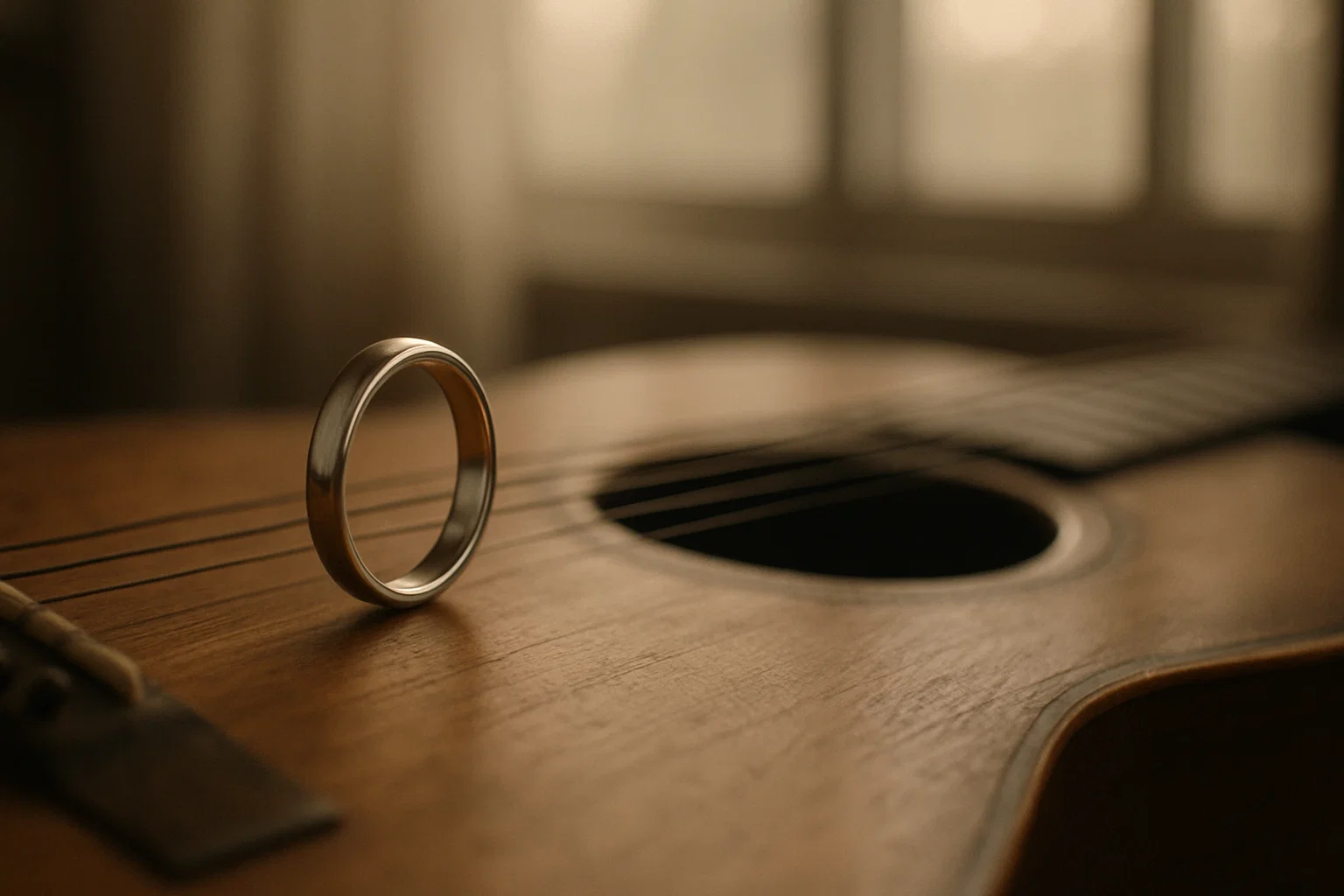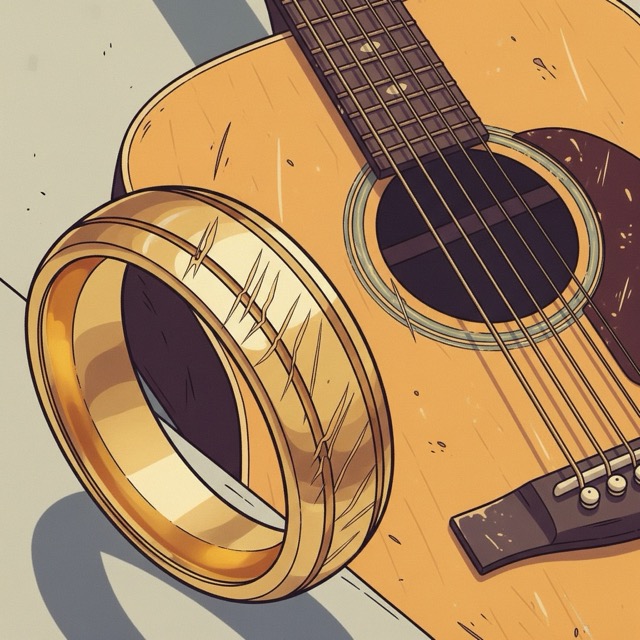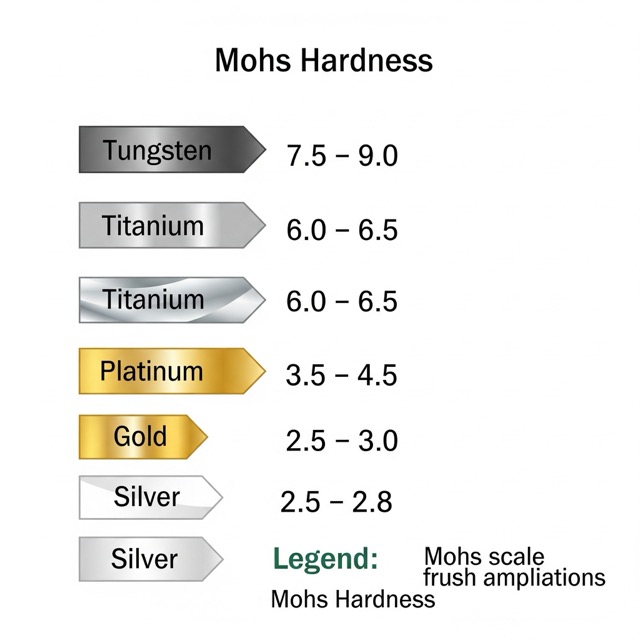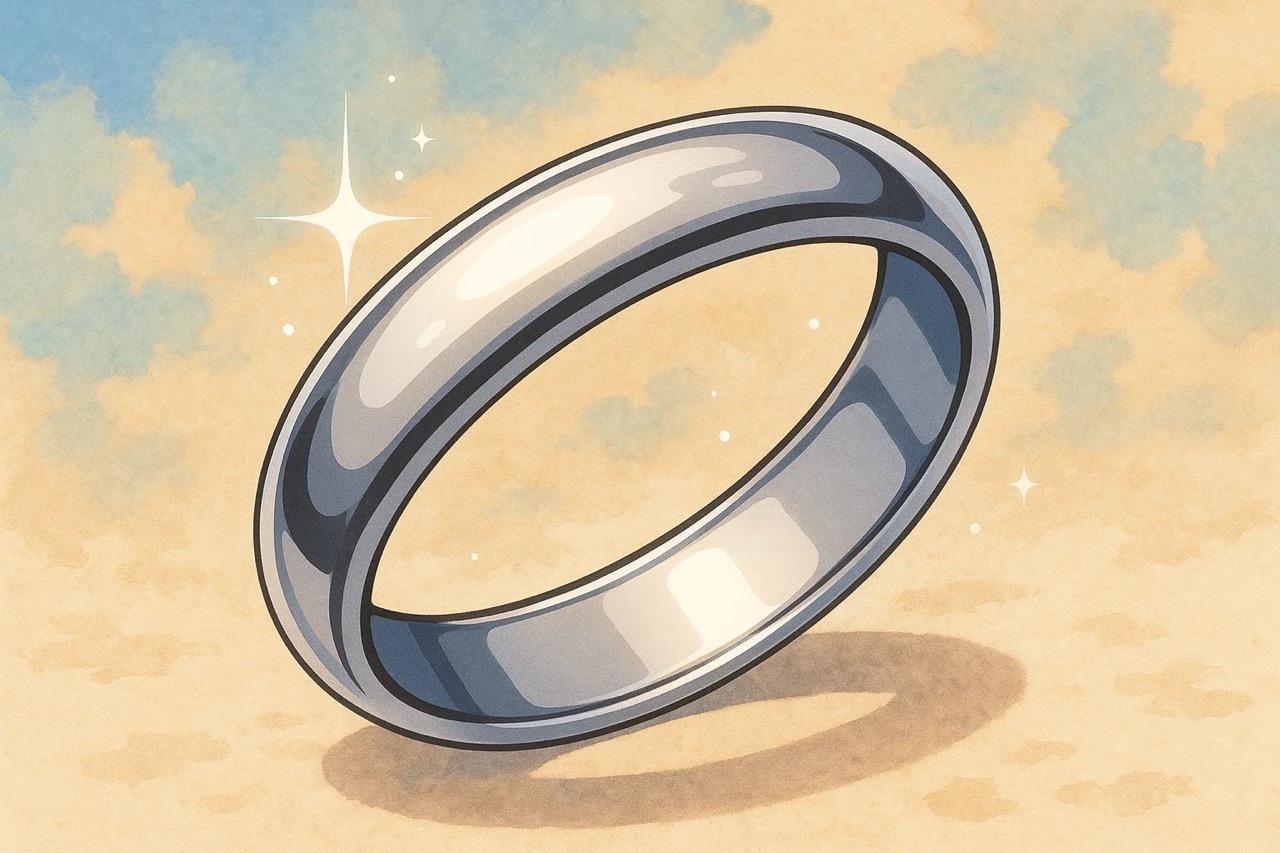Hello! I’m Shohei Takamura, the founder of Guitar Prescription TAKAMURA.
For all of you who love the guitar, especially those approaching a major life milestone or just wanting to enjoy rings as a fashion statement, there’s a small dilemma that’s likely crossed your mind. I’m talking about the “guitarist and rings” issue. It just popped into my head, which is why I decided to write this article!

A precious ring and a beloved guitar. It’s a relationship every guitarist contemplates.
“Won’t a ring get in the way when I play guitar?”
“I want to wear a ring for fashion, but I’d hate for it to affect my playing…”
“Most importantly, what if my precious wedding ring gets covered in scratches from playing guitar?”
I bet many of you have had these thoughts.
In fact, I struggled with how to handle my own ring when I first got married. I actually played with it on for a while, but my precious wedding ring quickly got covered in fine scratches… After much thought, I eventually settled on a style of “taking it off when I play.”
On the other hand, you have rock stars like Yngwie Malmsteen, who shreds with incredible speed while wearing a ton of rings. They’ve become part of his character, and many of us have surely admired that look.
Then there are legends like the great Larry Carlton, whom I deeply respect, who plays his sweet, beautiful tones without ever removing the wedding ring from his left ring finger. It’s a wonderful sight, as if symbolizing that his music and life are one.
Is it possible to have the best of both worlds, like they do? This is a dilemma that perhaps every guitarist faces at some point.
So, in this article, I’d like to tackle this timeless theme of “the guitarist’s ring problem” head-on, drawing from my own experiences.
From the unwanted “click!” of a ring hitting the strings, to the snagging that hinders smooth fingering, and the issue of “scratches” on both your beloved guitar and your precious ring… I will break down each of these unique guitarist troubles and provide a thorough, guitarist’s-perspective guide to realistic solutions for those who still wish to wear a ring.
By the time you finish reading this, the uncertainty will have cleared, and you’ll surely have found the “best way to coexist with your ring.” Let’s find that answer together!
- The Short Answer: What’s the Ideal Relationship Between a Guitarist and a Ring?
- Left-Hand Issues: The Specific Impact of Rings on Your Playing
- Right-Hand Issues: The Surprising Pitfalls for Picking & Strumming
- The Biggest Concern: The “Scratch” Problem for Both Ring and Guitar
- For Those Who Still Want to Wear a Ring: Realistic Solutions and Tips
- Conclusion
1. The Short Answer: What’s the Ideal Relationship Between a Guitarist and a Ring?
With so many concerns and feelings wrapped up in this issue, let’s start by taking a deeper look from the perspective of a guitar instructor and a fellow guitarist.
If your goal is to improve your playing quality and sound by even 1 millimeter or 1 percent, what is the ideal answer?
It would probably be to “take your ring off when you play.”
- ① It completely eliminates any physical interference with your playing.
(Prevents snagging during fingering and avoids unintentional noises.) - ② It completely eliminates the risk of scratching both the guitar and the ring.
(Protects your valuable guitar and, more importantly, your precious ring.) - ③ It allows you to concentrate 100% on your playing.
(Prevents that split-second hesitation—”Oops, my ring might hit”—that can lower the quality of your performance.)
In a professional setting, like a recording session where a perfect take is required, the reality is that the vast majority of guitarists remove their rings to eliminate even the slightest risk.
…But while that’s one rational way to think about it…
The fact that we can’t just easily accept that is what makes us human, what makes us interesting and lovable, isn’t it?
A wedding ring, in particular, is not just an accessory; it’s a symbol of the bond with your partner. It’s perfectly natural to want to wear it at all times. For others, a fashion ring might be an integral part of their style and identity.
Therefore, the purpose of this article is not to unilaterally recommend that “everyone should take off their rings!”
The goal here is to help you fully and deeply understand the pros and cons (the risks) of playing with a ring on. Based on that understanding, and using the specific impacts and various solutions we’ll discuss as “decision-making tools,” my aim is to help you find a way of coexisting with your ring that you can be truly happy with.
The ideal is important, but your feelings are just as important. Let’s find the perfect balance for you by looking at both sides.
2. Left-Hand Issues: The Specific Impact of Rings on Your Playing
The left hand (or the right hand for lefties) is the heart of guitar playing, creating the pitches.
That’s why the impact of a ring on these fingers is more significant and critical than you might imagine.
Let’s break down which fingers are most problematic and exactly what kind of playing they interfere with.
Impact Ranking! Which Finger is the Hardest to Play With?
Let’s look at this from a practical standpoint, ranked in order of impact.
-
1st Place: Index Finger
The index finger might actually be the most affected. The biggest reason is the “barre chord” (or séh/barre), as exemplified by the F chord.
When barring, the index finger presses the strings from the side, at an angle that’s nearly flat against the fretboard. This is when the protrusion or thickness of a ring can make direct contact with the 1st or 6th string, or the edge of the fretboard itself.
This can make the barre unstable, preventing certain strings from ringing out clearly, or cause a “clicking” noise. Since barre chords are a fundamental skill for guitarists, the impact here is arguably the highest.
-
2nd Place: Ring Finger
The ring finger, where many people wear their wedding band, is also highly affected. The main issues are “restricted movement” and “noise.”
A wide ring can slightly impede the free movement of the finger joint, making fast passages feel constrained. The most noticeable issue arises during bends and vibrato. As you push or shake the string, the ring can hit adjacent strings or frets, creating a very distracting “click-clack” noise.
-
3rd Place: Middle Finger
For the same reasons as the ring finger, the middle finger is also susceptible. It’s heavily used in rock and blues solos, greatly influencing a phrase’s expressiveness. During techniques like single-note bends, hammer-ons, and pull-offs, it’s very common for a ring to hit the strings or frets and cause unwanted noise.
-
4th Place: Pinky Finger
You might think, “I don’t use my pinky much, so it should be fine,” but that’s not necessarily true. Precise control of the pinky is essential for tension chords used in jazz and for technical, fast passages.
Especially for guitarists with smaller hands, a ring on the pinky can be a critical handicap. In situations where you think, “If I could just reach a few more millimeters, I could get to that fret…,” the mere 1-2mm thickness of a ring can become an insurmountable wall.
The “Two Big Problems” That Plague Guitarists
So what specific problems arise? They can be boiled down to two main issues: “noise” and “fingering obstruction.”
① The Noise Problem: That Unpleasant “Click!”

During bends or vibrato, a ring can make contact with strings or frets, causing noise.
Many of you have likely experienced this. You’re playing a clean arpeggio or pouring emotion into a solo, and suddenly you hear a metallic “click!”
This happens when a ring (especially a metal one) makes contact with other metal parts, like the strings or frets. This noise is particularly prone to occurring during string bends and vibrato.
As the string’s vibration amplitude increases, the ring can hit the adjacent string or fret. This kind of noise can ruin the mood of a performance. It’s especially noticeable with acoustic guitars or when using a clean, low-distortion sound, and would be considered an unacceptable level of noise in a recording environment.
② Fingering Obstruction: “Snagging” and “Restriction”
The other major problem is simply the difficulty in playing, the physical interference with your fingering.
The thickness and width of the ring subtly limit the independent movement of your finger, making it feel somewhat restricted. Or, during a chord change, the ring momentarily snags on the edge of the fretboard, causing a delay in your timing. The accumulation of these small stresses can degrade the overall quality of your playing.
This problem can feel even more severe for those with smaller hands or shorter fingers. Smooth fingering is a guitarist’s lifeline. The presence of a physical obstacle is more stressful than you might imagine.
Left-Hand Key Points: The main sources of interference are “unwanted noise” and a “feeling of restriction” in your fingering. The impact is most noticeable when barring with the index finger or doing bends/vibrato with the ring and middle fingers.
3. Right-Hand Issues: The Surprising Pitfalls for Picking & Strumming
Now that we’ve looked closely at the effects on the left hand, you might be thinking, “Well, my picking hand should be mostly fine, right?”
And it’s true that the direct impact on playing is less than with the left hand. However, depending on your playing style and sensitivity, the right hand has its own surprising pitfalls.
① Noise and Snagging During Palm Muting
This is particularly relevant for guitarists who play rock or metal and carve out heavy, chunky riffs.
When you palm mute (placing the side of your hand on the bridge to dampen the strings), a ring on your pinky or ring finger can “click” or “scrape” against the metal parts of the bridge, like the saddles or plate. This unintentional noise becomes more noticeable the tighter your riffs are, and can compromise the sharpness of your rhythm.
Besides the noise, the feeling of the ring snagging on the bridge can hinder smooth picking and become a subtle source of stress during play.
② The Impact on Strumming Feel (Centrifugal Force)

A heavy ring can affect the delicate feel of picking and strumming.
This might seem a bit niche, but for guitarists who value the delicate feel of their right hand, it’s a very important issue.
When you wear a ring with some weight (like one made of platinum or gold), it can change the “feel” of your strum as you swing your arm for strumming or cutting. It’s easier to understand if you imagine a small weight attached to your fingertip.
This slight weight affects the centrifugal force of your strum. Even if you think you’re swinging your arm the same way, your picking trajectory can unconsciously stray, or the feel of your wrist snap can be thrown off. Of course, this change may not be significant enough for everyone to notice. But if you’ve ever felt that “my cutting just isn’t sharp today,” it’s possible the cause was actually the weight of your ring.
③ The “Weight of the Finger” in Fingerpicking
Techniques like arpeggios and three-finger style require each finger to move with supple independence. Here too, the “weight” of a ring can come into play.
During delicate fingerpicking, the movement of the finger with the ring can feel somewhat heavy and dull. It’s a slight resistance, almost like wearing a tiny training weight on your finger.
This sensation can hinder your finger’s ability to keep up during fast passages or subtly throw off delicate dynamic control. Again, this is a very subtle sensory issue, but for a guitarist striving to master fingerpicking, it can be a noticeable source of discomfort.
Right-Hand Key Points: The impact is more limited, but problems can arise in more subtle areas, such as “contact noise” during muting and “changes in feel” during strumming or fingerpicking.
4. The Biggest Concern: The “Scratch” Problem for Both Ring and Guitar
The impact on your playing can, to some extent, be managed with practice and adjustments to your style.
However, the “scratch” problem we’re about to discuss is far more serious, as once the damage is done, it’s very difficult to reverse.

Over time, a ring and a guitar can end up scratching each other.
Here, we’ll look at the risks from both perspectives: the damage to your ring and the damage to your guitar.
Scratches on Your Precious Ring
What Causes the Scratches?
The culprits are the countless “metal parts” on your guitar.
In normal playing, you use the pads of your fingers to press the strings, so a ring may not often touch the strings or frets directly. However, if your form breaks down or your finger slips for a moment, the ring can unexpectedly “clink!” against a string or fret.
This momentary contact between two hard objects gradually carves scratches into your ring, which is made of softer precious metal. In other words, as long as you play guitar, you’re constantly facing the risk of accidental contact and scratches.
“So, is my ring safe?” A Comparison of Scratch Resistance by Material

Common wedding ring materials like platinum and gold are softer than the metal parts of a guitar.
Let’s look at how scratch-resistant common ring materials are. One measure of a material’s hardness is the “Vickers hardness scale (Hv).” A higher number means the material is harder and more scratch-resistant.
- Platinum (Pt900, etc.)
The classic choice for wedding rings, but it’s very soft among jewelry metals (Hardness: approx. 50-60 Hv). Compared to guitar strings (nickel strings are over 100 Hv) and frets, the difference is clear. It’s undeniable that it will get fine scratches from accidental contact. In fact, this is exactly what happened to my wedding ring. - Gold (18K, etc.)
A bit harder than platinum, but still a soft metal (Hardness: approx. 120-150 Hv). It’s about as hard as, or softer than, the metal parts of a guitar, so scratches are still unavoidable. - Silver (SV925, etc.)
Popular for accessories, but even softer than platinum (Hardness: approx. 25-40 Hv) and very delicate. It will likely get scratched if you play guitar with it on. - 【Scratch-Resistant Material ①】Titanium
Recently popular for wedding rings. It’s very hard (Hardness: approx. 170-220 Hv) and significantly more scratch-resistant than platinum or gold. - 【Scratch-Resistant Material ②】Tungsten
Boasts incredible hardness, second only to diamond among metals (Hardness: approx. 1400-1800 Hv). Guitar parts stand no chance of scratching it. However, because it’s so hard, it can “shatter” from a sharp impact, and resizing is nearly impossible.
The bottom line is that most common rings made of platinum or gold will likely get scratched to some degree from accidental contact during guitar playing.
Scratches on Your Precious Guitar
So far, the ring has been the “victim,” but now let’s consider the case where the ring is the “aggressor.” This is especially true if you wear a ring made of a hard material like titanium or tungsten, as the damage to the guitar can be more severe.
- Damage to the Neck Side and Fretboard
During fingering, the ring can make contact with the side of the neck (around the edge of the fretboard), causing scratches or dents in the finish or the wood itself. This is particularly likely to happen when your fingers get clumsy during chord changes. - Damage Around the Bridge
When palm muting with your right hand, the ring can hit the bridge plate or saddles, causing scratches.
You should be especially careful with guitars that have a “nitrocellulose lacquer finish,” which is common on vintage and high-end models. A lacquer finish is very delicate, and a hard object like a ring can easily cause scratches and dents. Repairing a deep scratch can be very expensive.
The Scratch Dilemma: A soft ring (like platinum) gets scratched by the guitar, while a hard ring (like titanium) scratches the guitar. Understanding this trade-off is crucial.
5. For Those Who Still Want to Wear a Ring: Realistic Solutions and Tips
We’ve talked in detail about the various risks that come with wearing a ring. You might be feeling a bit discouraged, thinking, “I guess I have to give up on playing guitar with a ring…”
But please don’t worry. The goal of this article isn’t to scare you or make you give up on wearing a ring.
Now, we finally get to the realistic and positive solutions to this timeless guitarist’s dilemma. For those of you thinking, “I want to protect my playing quality, my precious ring, AND my beloved guitar!” I’ve compiled some concrete strategies. There’s no single perfect answer. Try combining these ideas to find a style that works for you.
【The Basic Habit】① Get Used to Taking It Off Only When You Play
This is the most reliable and safest way to eliminate all risks. I can almost hear you saying, “I already know that,” but the key is to establish a “system for not losing the ring.” To do that, decide on a “designated spot” for your ring.
- Inside the accessory compartment of your guitar case.
- On a specific spot on top of your home amp.
- Get a dedicated ring case or a small pouch to keep it safe.
Take the ring off before practice or a gig, and always put it back in its spot when you’re done. Turn this routine into a “ritual,” just like tuning your guitar or plugging in your cable.
【An Investment in the Future】② Choose a Ring Made of Highly Scratch-Resistant Material
This option is for those who are about to buy a ring, especially those getting married. As mentioned earlier, metals like titanium and tungsten are incredibly scratch-resistant compared to traditional platinum or gold. Nowadays, there are many stylish wedding ring designs using these new materials.
Honestly telling your partner, “I’m a guitarist, and I’m really concerned about scratches,” and then looking for a scratch-resistant ring together is a very wise choice.
【Avoid with Design】③ Choose a Simple Ring with Few Bumps or Edges

A simple, domed ring with a smooth surface (like a “comfort-fit” band) minimizes the impact on your playing.
Just as important as the material is the ring’s design. Needless to say, “simple is best.” Choose a design with few bumps or edges, like a smooth “domed ring” (comfort-fit) or a flat “flat band ring.”
These designs minimize damage in case of accidental contact with the guitar and have less impact on your fingering. Conversely, rings with prong-set stones, intricate carvings, or sharp edges are riskier for guitar playing and are best avoided.
【Change the Location】④ Wear It on a Necklace While Playing
“It’s my wedding ring, I want to keep it on my body even during practice…” I completely understand that feeling. For those people, I recommend this method. Just take the ring off when you play and wear it on a chain necklace.
This way, you don’t have to worry about losing it, and you get the peace of mind that your precious ring is always with you. You can even find necklaces with a special “ring holder” feature that makes it easy to attach your ring, so it’s worth checking those out.
【A Hybrid Approach】⑤ Decide to Wear or Remove Based on Your Practice Routine
You don’t always have to think in terms of “100% on” or “100% off.” Another option is to be flexible and decide based on what you’re practicing that day.
- Practicing technical playing or cutting? → Take it off.
- Studying theory or focusing on gentle chord strumming? → It’s probably OK to leave it on.
By setting rules for yourself like this, you can create a balance, ensuring you have time to wear your ring while still being able to focus during high-risk practice sessions.
【The Last Resort】⑥ Get a “Dummy Ring” for Playing Guitar
This is a slightly different approach. Take off and safely store your precious wedding ring before playing. Then, while you’re playing guitar, wear an inexpensive fashion ring that you don’t mind getting scratched.
For those who feel unsettled without anything on their finger or for whom the feeling of wearing a ring is part of their style, this could be a surprisingly effective solution.
【The Most Important Thing】⑦ Talk Honestly with Your Partner and Make Your Own Rules Together

More than anything, communication with your partner is key.
This is the most important thing of all. Especially in the case of a wedding ring, this is not just your problem.
- That you are a guitarist who loves playing the guitar.
- That the ring, the symbol of your bond, is just as—or even more—important to you.
- But, that there’s a high probability the ring will get scratched from playing.
- And so, you want to figure out together how you can cherish both.
Try conveying these feelings to your partner honestly and in your own words. Based on that conversation, create your own set of rules, like “I’ll take it off just when I’m playing, okay?” or “If it gets scratched, can we think of it as proof that I’m working hard on my guitar?”
With the invaluable support of your partner’s understanding, you’ll be free from guilt and anxiety, and you’ll be able to truly enjoy a life with both your guitar and your ring.
6. Conclusion
So, what did you think about the guitarist and ring problem?
This issue is not just about “is it easy or hard to play,” but a delicate theme that involves a complex mix of the physical problem of “not wanting to damage precious things” and the psychological desire to “wear it always.”
What I wanted to convey throughout this article is just one thing: “There is no perfect answer. That’s why it’s crucial to understand the risks correctly and then find ‘your own rule’ that you are truly happy with.”
There are pros like Larry Carlton who play brilliantly with their rings on, and there are pros who choose to take them off to protect them. Both choices are equally respectable and wonderful styles for a guitarist and a person to have.
I would be thrilled if the knowledge and tips introduced in this article could help you establish your own style.
Your guitar and your ring are both irreplaceable treasures that enrich your life. Please continue to cherish them both and have a wonderful guitar life. I’m sincerely rooting for your musical journey.




Comments